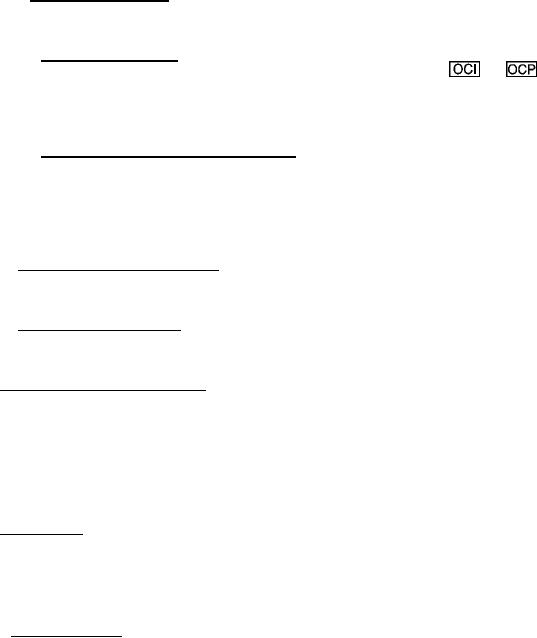
MIL-STD-38784A
4.3.10.6 Observable criticality. If equipment to be operated or maintained has observablity critical
requirements, e.g., radar cross-section/signature, applicable cautions shall be incorporated to ensure that
equipment is not degraded during operation and maintenance.
4.3.10.6.1 Observable criticality. Unless otherwise speciied (see 6.2.z.), all observable critical items (OCI)
and observable critical processes (OCP) shall be marked with the symbol
or
as applicable. When
approved by the acquiring activity, the symbols **OCI** and **OCP** may be used in lieu of the boxed
symbol. The symbol shall be prepared in the same style and size as the applicable paragraph sidehead. Only
the text version of the symbol shall be used in the applicable TOC paragraph title.
4.3.10.6.2 Observable critical symbol explanation. When applicable, the Foreword/Preface/Introduction
shall include the symbol, an explanation of the symbol, and other pertinent information to emphasize
the uniqueness of observable critical features. This shall include an explanation that all paragraphs,
procedures, items, and steps identiied by the OCI or OCP symbols must be followed as written, or the
components handled in such a manner that ensure surface integrity is not degraded. This explanation shall
be preceded by a CAUTION heading.
4.3.11 Energy eficiency requirements. When speciied (see 6.2.aa.), TMs covering products that directly
consume energy in normal operations, and that commonly have a method of expressing energy eficiency,
shall include their energy eficiency.
4.3.12 Environmental protection. All TMs that require the use, transportation, handling, storage or disposal
of fuels, toxic and hazardous substances, chemicals, ordnance/munitions, etc, shall meet the requirements of
the Federal Environmental Protection Standards.
4.4 Security classiication markings. The overall classiication assigned to a TM shall agree with the
highest classiication assigned to any portion within and Security classiication markings shall be in
accordance with DOD 5220.22-M and 5200.1-R.
(F) Electronic presentation: In addition to being placed on the title screen, security classiications shall
appear in the footer area of the viewer per the requirements of MIL-DTL-87268, section 3.
Print presentation: Security classiication markings shall be placed conspicuously at the top and bottom of
the Cover/Title page or abbreviated title and shall be placed in accordance with 4.2.1.4.1.1, 4.2.1.4.2.4.
4.5 Front matter. Print presentation: Unless otherwise speciied (see 6.2.ab.), material preceding the irst
chapter shall consist of the following in the order speciied in table III.
(F) Electronic presentations: The Table of Contents, List of illustrations, List of Changes, List of
Emergency Procedures and List of Tables shall be included as part of the left pane per the requirements of
MIL-DTL-87268.
4.5.1 Cover/Title Page. Manuals shall have either a cover or title page/screen, or an abbreviated title.
When speciied (see 6.2.ac.), there shall be a cover and title page/screen. (F) Cover page shall not be
used. The cover/title page/screen shall contain the information indicated by igure 1. Figure 1 also lists
the requirements for abbreviated titles. Abbreviated titles shall be used only when speciied by the
acquiring activity (see 6.2.ad.). Unless otherwise speciied (see 6.2.ah.), the TM identiication number will
be furnished by the acquiring activity.
Print presentation: (F) (M) (N) If there is both a cover and title page, the date shall be omitted from the
cover page. When speciied (see 6.2.af.), a manual shall require a backbone for binder or cover. FRC for
certain information such as the supersedure notice, supplement notice, disclosure notice and destruction
notice, as applicable, may be placed on the reverse side of the title page if additional space is needed
to avoid overcrowding of the title page (i.e. small TMs such as Job Guides and Work Cards) see
igure 10. The reverse side of the title page, when used as a continuation of the title page, shall be
numbered as described in 4.2.2.2.2.1.
(A) (N) The T-2 page shall be used only if absolutely necessary when reduced type size and leading will
not allow all information to be presented on the title page. When a T-2 page is used, (see 6.2.ag.) a
statement shall be placed on the title page indicating which information has been moved to the T-2 page.
(M) See igure 46 for cover/title page example.
24
For Parts Inquires call Parts Hangar, Inc (727) 493-0744
© Copyright 2015 Integrated Publishing, Inc.
A Service Disabled Veteran Owned Small Business